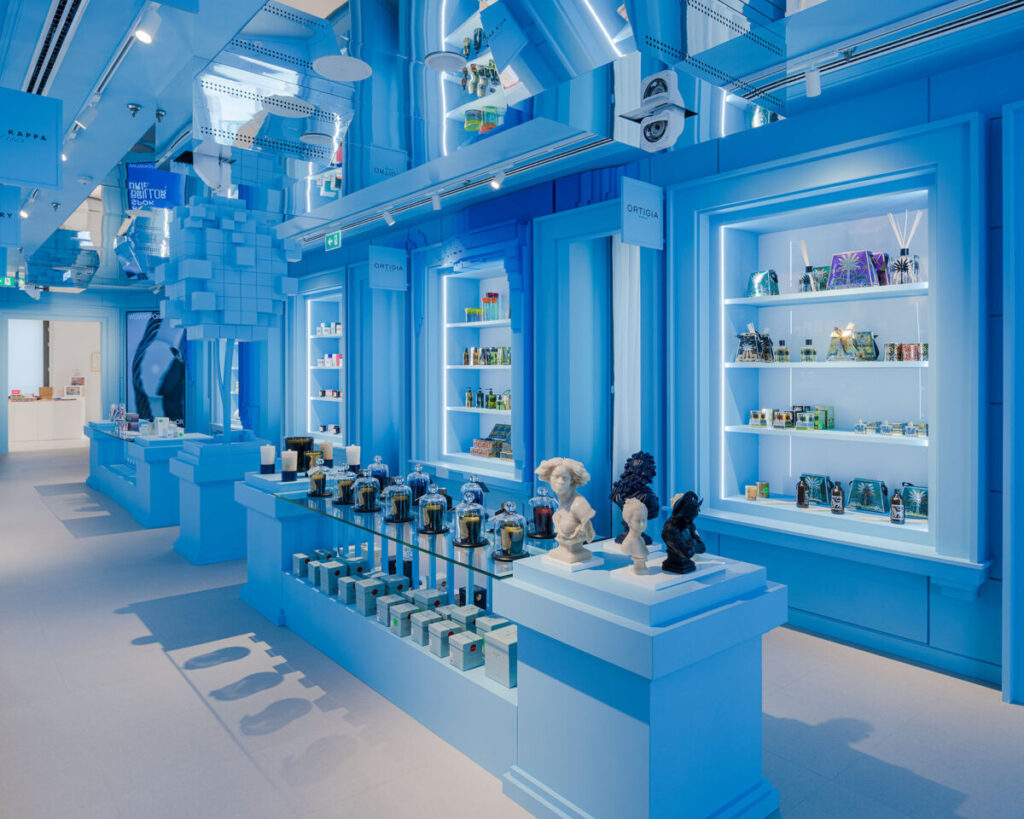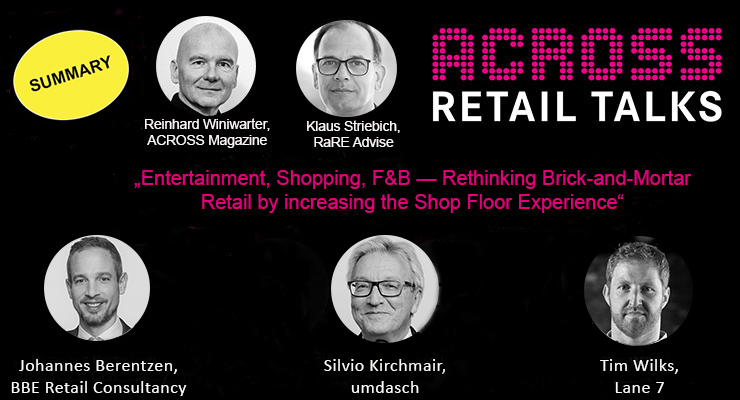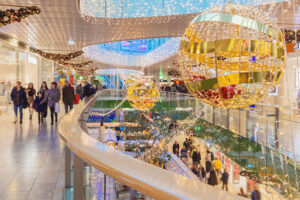ACROSS focuses on current industry topics in its regular Retail Talks. In this edition, moderator Klaus Striebich (RaRE Advise) and Reinhard Winiwarter (ACROSS Magazine) discussed why the old KPIs of the placemaking industry are no longer sufficient and why we need new KPIs that reflect the “experience” factor in particular.
The discussants of this episode were:
- Dr. Johannes Berentzen, Managing Director of BBE Retail Consultancy
- Silvio Kirchmair, CEO of umdasch
- Tim Wilks, founder of Lane7 and Level X

Experience Per Square Meter Vs. Sales Per Square Meter
Dr. Johannes Berentzen of BBE Retail Consultancy believes that retail is no longer just about financial KPIs like revenue per square meter. There are numerous stores where customers cannot even purchase anything locally, e.g. the WOW Concept store in Madrid. “I would argue that even if online sales, service sales, and retail media revenues are considered, customer experience has become the ultimate KPI. Customer satisfaction, recommendation rate, and conversion have become central in measuring success. Retailers need to rethink spaces as places of engagement, and not only as sales locations. Measuring experience per square meter is possible by looking at formative constructs like atmosphere, interactions, and services, and reflexive constructs like customer satisfaction, loyalty, and engagement. These directly influence how customers perceive their shopping experience, and are all measurable results of experiences. Formative and reflexive constructs – combining these factors allows one to build KPIs around the experience per square meter.”

WOW Concept Madrid
WOW is a so called „department store of the future” and one example of a retailer who (re-) thinks floor experience. Find more examples of innovative store concepts here: https://www.across-magazine.com/rethinking-floor-space-how-to-increase-experience-per-square-meter/
credit: WOW Concept Madrid
Further store concepts mentioned in our Retail Talk:
- Bründl Sports
- Harrods
- Johnny Walker Edinburgh
- KaDeWe
- LEGO Store Berlin
- L&T Osnabrück
- M&M´S Berlin
- Nike House of Innovation, Paris
- Starbucks Reserve
- WOW Concept Madrid
- Xperion Berlin
Silvio Kirchmair, CEO of umdasch The Store Makers, also emphasizes the importance of the shopping experience: “About 80% of stores still measure traditional KPIs, but for the rest it is not only about simple efficiency anymore. There are other drivers such as qualitative experiences that need to be considered. Many of our clients tell us they want an “instagrammable” store. In my observation, since the past few years, a significant number to measure is not only the duration of stay, etc., but also the number of social media reactions on a store. One of the best examples is Nike´s House of Innovation in Paris. You can buy the brand´s products there, but the store is primarily there to tell a story and communicate with the customers. And to do that more efficiently, they measure online reactions on a daily basis. This is also what many of our customers are looking for: social media content that they can feel addressed by.”
Tim Wilks, Founder of Lane 7 and Level X, explains what strategy they use at Lane 7 to enhance customer experience: “One of the biggest factors we concentrate on at our locations is dwell-time. You need a hook, but just one service is not good enough since customers will treat you as a regular transactional business and leave as soon as they acquire what they came for. Therefore, we offer one primary product, which is bowling, and build smaller offers around it that are cheaper to manage and are bigger in volume so that they will keep customers engaged even before or after arriving at our top-selling product. Additionally, we do not require customers to pay when ordering a service, or consuming from the bar´s menu. They can engage in leisure activities, order food and drinks, and pay only at the exit. Our market is growing, and Lane 7 is part of the current reinvention cycle at shopping centers, where providing day-out experience is becoming more vital.”
Creating A Retail Experience That Makes Customers Want To Visit Again
Berentzen argues that “Physical stores must become more and more service-oriented. They need to offer an experience that makes it worth leaving the house for. When it comes to e-commerce, traditional retail cannot compete with the cost structures unless physical stores offer more than just products, which then make consumers give up on comfort. Customers nowadays are well-prepared and often know what they want even more than the staff at stores. That is why retail must evolve from a place of education to a place of inspiration.”
Wilks agrees with Berentzen by saying: “The aspect of listening to customers and giving them what they want is crucial, and it is also what we prioritize. We pay attention so that customers at our locations can curate their best experiences themselves. In turn, this leads them to positively surprise themselves, which makes for a unique experience.”
“Retail has changed with the emergence of mobile phones, especially when it comes to consumer expectations,” Wilks continues. “With social media driving consumer expectations higher and higher, retailers now also compete more intensely. Therefore, we make about 25% of our floor area into a space that can be easily reinvented at a relatively low cost. If we find a new hook that we feel is relevant – a good example would currently be VR, which is a big trend that makes people visit our locations – even if it only lasts for two or three years, we invest in it, and once the trend is past its prime, we reinvent the same area as something new.”
Kirchmair adds: “Change for the sake of change is not a good concept because it just creates extra costs. Since continuous dramatic changes often do not work as intended, gradual change is much more preferable for retailers, and that is what we also recommend our customers.” If a retailer´s concept and strategy is working as intended then offering occasional surprises, and introducing smaller changes is more beneficial. Drastic changes need to be kept as a last resort for cases where a concept or strategy is not working.
Retail And Entertainment Benefiting From Each Other
“When combining entertainment and retail, a widespread strategy is the use of collaborative events,” explains Kirchmair. Such events are beneficial for all parties involved as long as they align with the retailers´ strategies, e.g. combining luxury retail with entertainment, or sports with sports events. A good example is the collaboration between Lululemon and a sports retailer, where the sports store was redesigned in the evenings to encourage practicing yoga among visitors. To give another example, simply introducing a discount on a product might increase footfall at a store for a period of time, but it might not necessarily align with every collaborator´s strategy.”
Wilks adds: “Among our current cooperations, we are working with a large sports brand to produce our line of bowling shoes. What has to be kept in mind here is that partnerships are about the synergy between the cooperating brands and their followers. Not all relations have to be equal, either. As our cooperation shows, our partner is far bigger than us, yet, working with a smaller brand can also bring credibility.”
Watch the whole Retail Talk here:
Recommendations for the industry

Berentzen: „Retail success is no longer about transactions; it’s about relationships. This is also relevant for collaborations, which are key to keeping things fresh and engaging. I recommend staying creative, and working towards achieving a balance between digital convenience and physical engagement to further enhance the shop floor experience.”

Wilks: “Flexible design is important, so do not simply design units for retail. For retail to be successful big and small businesses alike need to blend all the income into yield to have a destination that the consumers really want.”

Kirchmair: “As an entrepreneur it is important to reduce your leverage, i.e. to increase equity, and remain volatile. Moreover, implementing third spaces at retail locations is a must.”






